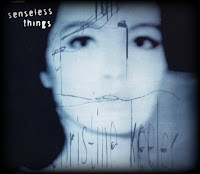The high grey-flannel fog of winter closed off the Salinas Valley from the sky and from all the rest of the world. …
… Elisa Allen, working in her flower garden…
… She was cutting down the old year’s chrysanthemum stalks with a pair of short and powerful scissors. She looked down toward the men by the tractor shed now and then. Her face was eager and mature and handsome; even her work with the scissors was over-eager, over-powerful. The chrysanthemum stems seemed too small and easy for her energy. …
You’ve got a gift with things,” Henry observed. “Some of those yellow chrysanthemums you had this year were ten inches across. I wish you’d work out in the orchard and raise some apples that big.”…
The Chrysanthemums ~John Steinbeck
Chrysanthemums! I have to admit they are not my favorite flower. Roses, tulips, irises and dozens of others, yes, but not chrysanthemums.
Chrysanthemums are forever associated, in my mind, with the 1st of November, All Saints' Day.
Many, many years ago, on a foggy end of October afternoon, and it was the day before we were setting off for Venice, I was out walking thinking in anticipation of the trip. And there was the pastor peddling towards me on his bicycle and about to dismount for a few rounds of seasonal compliments and beatitudes. Dr. R., now dead, was a charming bachelor and a dear friend. He began to talk of flowers for All Saints’ Day, in church and graveyard, and I remember he told me his favorite flower was the chrysanthemum. I have never forgotten his remark because it saddened me and damped down my enthusiasm for the sights to come. The day we arrived in Venice, November 1st I watched families, with an obligatory pot of chrysanthemum, heading for the island of St. Michele, a sight not to be forgotten.
The sixteen-petalled chrysanthemum was the Mikado's crest or emblem, and the flower underwent every sort of embellishment that the florist's art could impart to it in Japan. The Japanese varieties must have arrived in Europe with something of a shock, to the growers as well as to themselves. And soon the enormous kinds were being grown, white or yellow, and the bronze, too, as big almost as bearskins, and which one associated with the drawing rooms of rich old ladies who had greenhouses. They were the kinds most admired in Edwardian days.
But in its land of origin the Japanese chrysanthemum went far. In a book on the subject, the following varieties are mentioned: thread-petalled; brush-flowered; the anemone varieties; thistle-flowered; piled-up; clutching (for whatever that portends!); thick, or medium, or thin-quilled; cascade chrysanthemums, and the variety I would call "gone haywire," or by the old word "frantick" with their frills or petals blown about in all directions as by a typhoon or "force nine" gale. Shock-headed or mop-haired chrysanthemums, in fact; but this is a development which occurs, too, in the plumage of certain races of fancy pigeons and poultry, and with human beings is to be seen among the learned and even in the highest echelons of the clergy, but only, I think, in Europe. "Christmas dinner: dare you be different?" This, in our best fashion paper, and a recipe follows for chrysanthemum salad. "Choose the round big-headed variety. Pluck all the petals off," and so on, and so on. And it is true that they make an excellent salad.

But is this any more peculiar than the "instant seaweed" that the Japanese eat for breakfast? Their oddity of diet is persistent, according to my point of view at least. The only surviving letter in the hand of Sotatsu, their seventeenth-century painter of gold screens and a decorative artist who ranks with Veronese and Tiepolo-though how different!-is a note to a monk acknowledging the gift of five roots of an edible bamboo for which the monastery was famous. The story has a particular appeal to me because I know the temple, and it is in Kyoto, which is one my favorite cities. Just now, what chrysanthemums must be on view there in the wooden temples and in the paper houses with the snow lying deep outside!
By no means all their chrysanthemum varieties have been exported. Is this a good, or a bad thing? I would not like to say. Yet, imagine having chrysanthemums on your scabbard and sword-belt, and even damascened upon your armor! Chrysanthemums, indeed, on everything, and practically everywhere.

At home we confined them to the cemetery on All Saints Day. Bless you grandma! And perhaps the village altar! And they know how to behave themselves. Or do they? I have seen chrysanthemum looking like an octopus, or squid, with spider-legs for tentacles. Or it is some kind of eccentric centipede. That is to say, its legs or petals are convoluted, jointless and very far from straight. It is curious, but I would call it anything but beautiful. Another one, resembling a stellar explosion, with huge bursting calyx in the middle and corona of pinkish rays, is certainly impressive, though to be averted or avoided if encountered in outer space. But it is only a specimen flower, and should taste superlative in a salad with olive oil and a zest of lemon added.
And there is yet another one with a sort of crab-like center. Can this be the variety the Japanese describe as "clutching?" For that will describe it. Whatever its sort, this one appears to be retracting, drawing back into itself, as sea-anemones do when you touch them. And so do hedgehogs which roll into a ball and tortoises which withdraw their heads into the shell. A kind of "sensitive plant," perhaps, among chrysanthemums.
There is nothing in the least frightening about chrysanthemums, though at the same time they are in close association with their owners, and may be to some little extent influenced by them.
Personally, I would avoid the freak ones and keep to the huge red kinds my aunt grew. I have always felt these are the lucky and benevolent sorts, and some of the others may have a little touch of the "evil eye" about them. In any case I would never trust them.
How many years it is since that October day! It was a difficult time of year, of course, with the worst still ahead, and without the cheerful anticipation of spring to come. At least there could be the salads to look forward to, but that apart it is a grim season. One had better make the most of it and stockpile with chrysanthemums, although I would never countenance them in my rooms because they are too stuffy and persistent. But neither are orchids desirable in the house. They are too possessive, and, it could be said, do all the talking.
But now the unexpected has happened. My neighbor Wilma has received a birthday present in the form of a Yorkshire terrier, a breed of dog I had never thought I could love. Its face and hair, eyebrows, whiskers, and all are exactly those of my un-favorite flower, but I am beginning to understand both Yorkshire terriers and chrysanthemums.






































